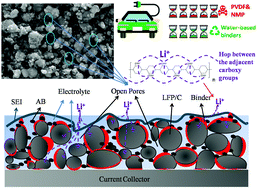Green water-based binders for LiFePO4/C cathodes in Li-ion batteries: a comparative study†
Abstract
Compared with the use of the environmentally harmful binder polyvinylidene fluoride (PVDF) in Li-ion batteries (LIBs), water-based binders have many advantages, such as low cost, abundant sources, and environmental friendliness. In this study, various green water-based binders and binder couples for preparing LiFePO4/C (LFP/C) cathodes in LIBs were first investigated systematically. Electrochemical tests indicated that electrodes with SA (E-SA) and electrodes with CMC/PTFE (E-CMC/PTFE) had outstanding performance. Especially in the rate performance (2C/0.1C), the values of E-SA and E-CMC/PTFE were 86.3% and 85.7%, i.e., 4.4% and 3.8% higher than those of electrodes with PVDF (E-PVDF) (81.9%), respectively. After 50 cycles, the discharge specific capacity of E-SA and E-CMC/PTFE was stable at 165 and 166 mA h g−1 (the theoretical value of LFP is 170 mA h g−1). All Rct (charge-transfer reaction resistance) values with water-based binders were smaller than the one with PVDF. E-SA, E-CMC/PTFE, and E-CMC/SA had smaller polarization than E-PVDF. E-SA and E-CMC/PTFE had an enhanced kinetics capability in Li+ transfer, which may be attributed to the large content of carboxyl groups in SA and CMC, and holes and open pores in electrodes. SEM and TEM images showed that E-SA and E-CMC/PTFE had a homogeneous coverage of AB on LFP, which is the key factor for an excellent conductive network and electrochemical performance. We believe that the environmentally friendly water-based binders have broad prospects for use in LIB cathodes.



 Please wait while we load your content...
Please wait while we load your content...